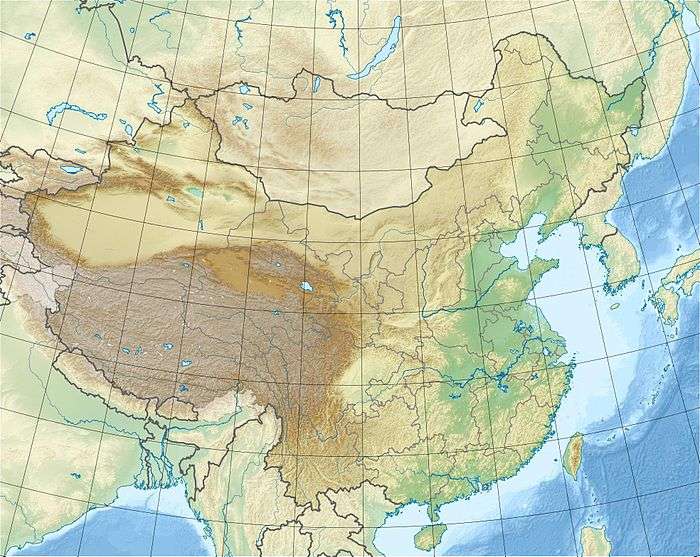1975 Haicheng earthquake
The 1975 Haicheng earthquake hit Haicheng, Liaoning in China at 19:36 CST on February 4. This earthquake had an Ms magnitude of 7.5,[3] which is associated with total destruction of infrastructure and property. Haicheng had approximately one million residents at the time of the earthquake, which is known for being one of the few earthquakes to be successfully predicted throughout history.[4]
 | |
| UTC time | 1975-02-04 11:36:06 |
|---|---|
| ISC event | 731961 |
| USGS-ANSS | ComCat |
| Local date | February 4, 1975 |
| Local time | 19:36 CST |
| Magnitude | 7.5 Ms; 6.2 mb[1] |
| Depth | 15.6 km |
| Epicenter | 40.66°N 122.68°E |
| Tsunami | None |
| Casualties | 1,328 killed (some say 2,041 [2]) |
Early in the morning of February 4, 1975, Chinese officials ordered that the city of Haicheng be evacuated, believing there to be a large chance of an earthquake occurring. The prediction was allegedly based on reports of changes in groundwater and soil elevations over the past several months as well as widespread accounts of unusual animal behavior. A low-level alert was triggered by regional increases in seismicity (later recognized as foreshocks).[5] Both authorities and citizens were finally placed on high alert and an evacuation order was issued due to an increase in foreshocks.[6] Though this particular prediction of the earthquake was initially believed to be just the latest in a recent string of false alarms that had occurred in the preceding months, including one case of an earthquake swarm being caused by the filling of a reservoir,[7] the evacuation of Haicheng proceeded anyway and eventually paid off.
The evacuation, despite successfully removing most of Haicheng's population, did not prevent deaths in its entirety. When the main quake struck at 7:36 pm, 1,328 (some says 2,041) people died,[8][9] over 27,000 were injured and thousands of buildings collapsed. However, the death toll was much lower than the estimate of over 150,000 dead which is believed to have resulted if the evacuation had not taken place.[10] This was the only successful evacuation of a potentially affected population before a devastating earthquake in history.
Another sign of the earthquake coming was the unusual animal behaviour. In December 1974, rats and snakes appeared "frozen" on the roads. Starting in February 1975 reports of this type increased greatly. Cows and horses looked restless and agitated. Rats appeared "drunk", chickens refused to enter their coops and geese frequently took to flight.[11]
In addition to damage in Liaoning Province and its surroundings, minor damage was also reported in Seoul, South Korea. The quake was felt in Primorskiy Krai, Russia, and in Kyushu, Japan.
In recent years, the success of the earthquake's prediction has come under scrutiny. Seismologists have agreed that the Haicheng earthquake can't be looked to as any sort of "prototype" for predicting future earthquakes, as the foreshocks that played a huge role in leading to prediction of this earthquake are not a regular, reliable occurrence before all earthquakes. However, Qi-Fu Chen, a research professor at Beijing's China Earthquake Administration, explained that this earthquake at least "showed the importance of public education," prompting a further discussion about the necessity of making the public aware of the dangers, preparations, and warning signs related to earthquakes.[12]
References
- International Seismological Centre. ISC-EHB Bulletin. Thatcham, United Kingdom, http://www.isc.ac.uk/ [Event 731961].
- "Earthquake Prediction: Haicheng, China – 1975". Eserc.stonybrook.edu. Archived from the original on 2016-03-18. Retrieved 2016-01-14.
- ISC-EHB Event 731961 [IRIS].
- "Historic Earthquakes". earthquake.usgs.gov. Archived from the original on 2015-10-03. Retrieved 2015-11-14.
- "Earthquake Prediction: Haicheng, China – 1975". www.eserc.stonybrook.edu. Retrieved 2015-11-23.
- "Earthquake Prediction: Haicheng, China – 1975". www.eserc.stonybrook.edu. Archived from the original on 2016-03-18. Retrieved 2015-11-14.
- Wang, Kelin; Chen, Qi-Fu; Sun, Shihong; Wang, Andong (2006). "Predicting the 1975 Haicheng Earthquake". Bulletin of the Seismological Society of America. 96 (3): 757–795. doi:10.1785/0120050191.
- Alexander, David C. (1993-07-29). Natural Disasters. CRC Press. ISBN 978-1-85728-094-4.
- "Major earthquakes on Chinese mainland since 1966". houston.china-consulate.org. Retrieved 2020-05-11.
- "Repeating Earthquakes". earthquake.usgs.gov. Retrieved 2015-11-14.
- Anonymous (1977), "Prediction of the Haicheng Earthquake", EOS, 58 (5): 234–312, Bibcode:1977EOSTr..58..236., doi:10.1029/EO058i005p00236
- "Historic Earthquakes". earthquake.usgs.gov. Retrieved 2015-11-23.
Further reading
- Susan Elizabeth Hough (2009). Predicting the Unpredictable: The Tumultuous Science of Earthquake Prediction. p. 272. ISBN 9780691138169.
External links
- The International Seismological Centre has a bibliography and/or authoritative data for this event.